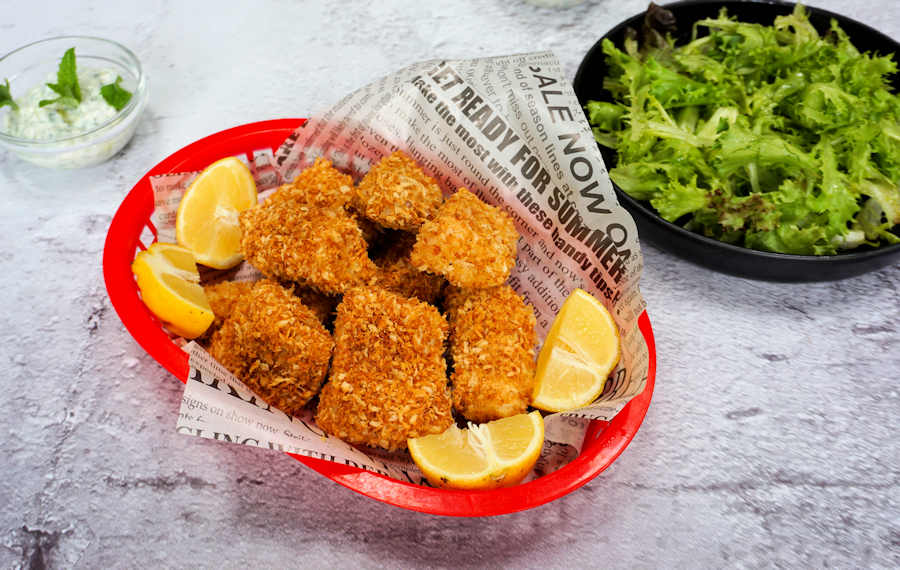Breaded haddock goujons, much healthier when baked in the oven and double-healthy served with Greek tzatziki instead of tartar sauce.

Why would you want to cut a nice, big fillet of fish into small pieces, instead of cooking it whole, or at the most individually portioned? What’s wrong with fish and chips? And why call it by a poncey name: ‘goujons’? What even are they?
What are goujons? Why goujons?
I’ll start from the end: goujons are small pieces of meat or fish coated in breadcrumbs and fried or baked. Which is why scampi is scampi instead of prawn goujons – it’s whole prawns breaded and fried.
And also, that’s why fish fingers are not goujons: the ‘poncey term’ does not apply to mashed up, minced and generally reconstituted fish or meat, however delicious they might be.
Next question: nothing wrong with fish and chips, NOTHING whatsoever. I’d be deep in trouble if I even suggested criticism of this national treasure: The Weather Man is a dedicated fish and chips enthusiast.
And lastly, cutting fish into chunks makes perfect sense if a/ you don’t want to set up the whole deep-frying shop, b/ you want to make it a reasonably healthy dish and skip frying altogether or/and c/ it’s to be served to the younger generation.
Children like mini foods
Kids get easily intimidated by large items of food on their plates, hence the popularity of meatballs and fish fingers amongst them.
Following my credo that kids should not be ghettoed into children’s option in restaurants (which usually features blatantly less healthy dishes than grown-up choices), tasting menus with their tiny portions would be ideal for them.
And I’m actually totally serious: adding to that the fun of lots of different things rolling up one after the other, including multiple desserts, I think I’m onto something here.
So whatever your motivation, a, b or c above, making goujons is completely sensible.
How to make healthy haddock goujons
Things in breadcrumbs when oven baked are very virtuous and undeniably healthier than their fried counterparts, but they usually emerge from the oven unappetisingly pale.
Crisp coating tastes immediately less crisp if it’s not deep golden and glistening with a little oil. And so, here’s the trick: toast the breadcrumbs deep golden and toss them with a little oil for the glisten before using them.
Except for the above trick, the rest of the process is boringly familiar: dredge through flour, dunk in egg wash and roll around in the doctored breadcrumbs.
Whether baked on a greased rack set over a tray or directly on the tray, they will be equally good and cook equally quickly: 15 minutes maximum.
What other fish for goujons?
Obviously, haddock is not the only choice of fish for the dish. Cod will taste just as nice, and don't spurn the less popular but more sustainable pollock, coley or hake which are white firm fish just like haddock and cod.
You can also use lemon sole and plaice, except the goujons will be less chunky as those fillets are thinner.
What sauce is best with breaded fish?
Fish is best served with tartar sauce – right? Wrong. At least if the tartar sauce is the gloopy mayonnaise with a few reluctant shreds of gherkin swimming in it.
If you should make tartar sauce at home from scratch, it would certainly be lovely but for whatever reason nobody does.
And tzatziki, Greek herby yoghurt sauce, is not only healthier but easy to put together. And it goes so well with breaded fish I’m amazed it isn’t served in chippies all the time.
More healthy fish recipes
Salmon and potato bake, one pan dinner, will also appeal to kids. And it’s very quick and easy to prepare.
Or go the whole hog and make a fish pie. My version is with sliced, rather than mashed potatoes.
Fish balls are like meatballs, only spelled as two words. Joking aside, these fish balls with Parmesan and capers are excellent, and can be made from a pie mix or fish offcuts collected over time in a freezer bag.
And let’s not forget sprats! You may know them as whitebait; it’s the only fish I’m happy to eat whole: head, bones and all.